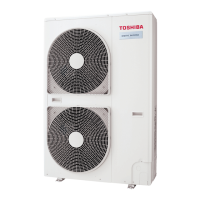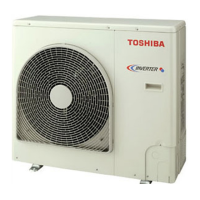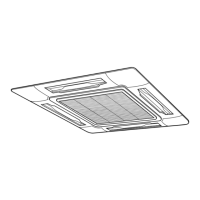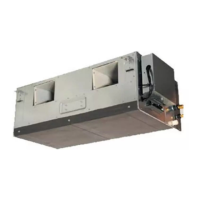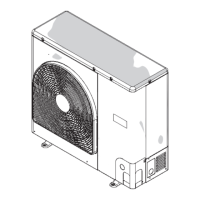Why does my Toshiba Air Conditioner show a phase sequence error?
- AAmanda DayAug 25, 2025
If your Toshiba Air Conditioner displays a phase sequence error, it is caused by an abnormal phase sequence of the 3-phase power supply.

Why does my Toshiba Air Conditioner show a phase sequence error?
If your Toshiba Air Conditioner displays a phase sequence error, it is caused by an abnormal phase sequence of the 3-phase power supply.
What does it mean if my Toshiba Air Conditioner displays an outdoor unit low-pressure system error?
If your Toshiba Air Conditioner displays a low-pressure system error, the Ps pressure sensor error was detected, or low-pressure protective operation was activated.
What does an outdoor unit current detect circuit error mean on my Toshiba RAV-SM1603DT-A?
If your Toshiba Air Conditioner is showing an error with the outdoor unit current detect circuit, it means abnormal current was detected in AC-CT, or a phase loss was detected.
What does a heat sink sensor error mean on my Toshiba RAV-SM1603DT-A Air Conditioner?
A heat sink sensor error on your Toshiba Air Conditioner means that the temperature sensor of the IGBT heat sink detected an abnormal temperature.
What does an indoor unit heat exchanger sensor (TCJ) error mean for my Toshiba RAV-SM1603DT-A Air Conditioner?
An error with the indoor unit heat exchanger sensor (TCJ) on your Toshiba Air Conditioner indicates an open-circuit or short-circuit of the heat exchanger sensor (TCJ) was detected, possibly due to an issue with the Indoor P.C. board.
What does an indoor unit heat exchanger sensor (TC) error mean on my Toshiba Air Conditioner?
If your Toshiba Air Conditioner shows an error with the indoor unit heat exchanger sensor (TC), it indicates an open-circuit or short-circuit of the heat exchanger sensor (TC) was detected. The cause may be the Indoor P.C. board.
What does an outdoor unit temp. sensor (TE/TS) error mean on my Toshiba Air Conditioner?
If your Toshiba Air Conditioner displays an error related to the outdoor unit temp sensor (TE/TS), it indicates an open-circuit or short-circuit of the heat exchanger temp sensor was detected, potentially due to the Outdoor P.C. board.
What does an outdoor unit outside air temp. sensor error mean on my Toshiba Air Conditioner?
If your Toshiba Air Conditioner displays an error related to the outdoor unit outside air temp. sensor, it indicates an open-circuit or short-circuit of the outdoor air temp. sensor was detected, potentially due to the Outdoor P.C. board.
What does an indoor unit room temp. sensor (TA) error mean on my Toshiba Air Conditioner?
If your Toshiba Air Conditioner displays an error related to the indoor unit room temp. sensor (TA), it indicates an open-circuit or short-circuit of the room temp. sensor (TA) was detected. The cause may be the Indoor P.C. board.
| Brand | Toshiba |
|---|---|
| Model | RAV-SM1603DT-A |
| Category | Air Conditioner |
| Language | English |
Crucial safety advice for installing the air conditioner to prevent hazards.
Important safety guidelines for operating the air conditioner to avoid risks.
Safety precautions when repairing or moving the air conditioner.
Additional installation precautions for safe and proper setup.
Further operational cautions for safe and efficient use.
Identifies and describes the components of the indoor unit.
Shows the separate sold part, the remote controller.
Identifies and describes the components of the outdoor unit.
Explains the various indicators and sections of the remote controller display.
Details the buttons and functions within the remote controller's operation section.
Steps for initial setup, power connection, and basic operating requirements.
How to select modes, air volume, and set temperature for operation.
Explains Auto Changeover, Heating, Defrosting, and 8°C Operation.
Step-by-step guide on setting and canceling timer operations.
Instructions for activating and deactivating the power saving mode.
Detailed steps to configure specific power saving settings.
Advice on temperature, ventilation, and curtains for energy saving.
Guidance on pre-operation checks and understanding protective device actions.
Instructions for cleaning air filters and the remote controller.
Steps for storing the unit and pre-operation checks.
Detailed list of parts requiring maintenance and recommended actions.
Explains protection features, power failure handling, and heating characteristics.
Details the recommended operating temperatures for cooling and heating.
Guidelines for choosing a suitable installation place and electrical connections.
Lists specific locations where the air conditioner should not be installed.
Steps to check before calling for service for common issues.
Describes noises or conditions that are not actual failures.

